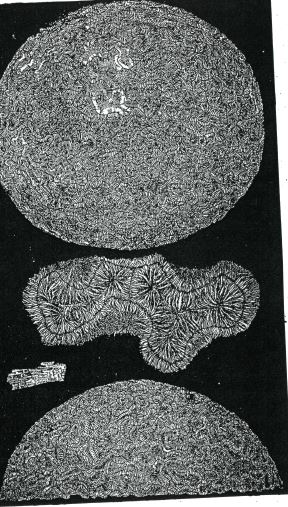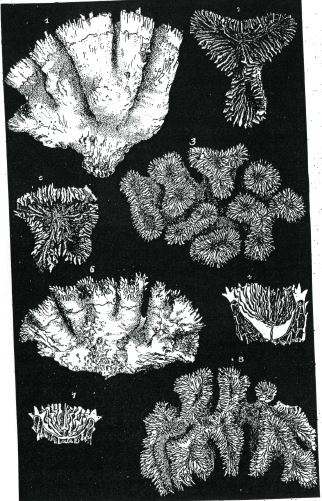page 128
On some CORALS from Darnley Island.
By the REV. J. E. TENISON-WOODS, F.L.S., &c.
Plates 9 & 11.
Among the many corals brought from Darnley Island by the Hon. W. Macleay, F.L.S., as the result of the Chevert Expedition, there are three which seem to vary sufficiently from any hitherto described to entitle them to specific description. At the same time I do not positively say that they are new species, as I am not sufficiently acquainted with the extent to which these reef-building forms vary in their modes of growth. The hemispherical Symphyllia here described does not appear to have any congener of its peculiar habit and size. The Mussoe form reefs round Darnley Island with many others, but especially Seriatopora subulata, Ellis. I propose shortly to give a list of all the North Australian forms, and in the meantime these species may be noted.
SYMPHYLLIA HEMISPHERICA, n.s. Plate 9, figs. 1, 2, 3, 4.
Corallum largely hemispherical; calices seldom simple, sometimes as many as eight in one valley; irregularly concave, shallow (from 4 to 6 millimetres in depth), with apparently six systems and four cycles, or occasionally five, but they are unequal and irregular, and very difficult to make out. Septa equal, the higher orders often uniting a short distance from the
page 129
columella, all armed with long spines which are longer exteriorly. Columella altogether rudimentary, not distinguishable from the contorted ends of the septa. Walls narrow, intimately united, leaving only a distinct deep sinuous groove of equal width. As the corallum is perfectly hemispherial and lies on a flat base, to the edge of which the calices are continuous, there is scarcely any epitheca to be seen. Underneath, the calices are nearly always in broken sections. Where they are complete the epitheca is thick, in rugose folds, with many round granulations. The calices on the base appear like radiating tubes. Endotheca very abundant and in regular planes, corresponding frequently on opposite sides of the septa, so as to seem almost like continuous floors across the tissue. Diameter of the corallum 360, alt. 180, length of valleys 20 to 85, lat. of crests of walls 5, lat. of calices 10 to 15 millim.
Plate 9, fig. 1, corallum seen from above much reduced in size; fig. 2, two valleys, nat. size; fig. 3, side view of calice from base, showing epitheca and endotheca; fig. 4, side view of corallum much reduced.
This coral differs from any described in being hemispherical. It is nearest in the character of its valleys to S. sinuosa, Dana. The calices are large, wide, and deep, but perhaps not so large as in the species just named. Darnley Island. The specimen from which the drawings were made is in the Macleayan Museum. Messrs. Quoy and Gaimard who describe S. sinuosa (Meandrina to them) say that it is almost flat. They quote Ellis for the fig. as p. 60, which should be p. 160, pl. 48. To Ellis it was a Madrepore. The figure is not good, but an attempt is made to express the mural valley by a white line. His diagnosis is Madrepora conglomerata; anf. palulis flexuosis, brevibus, dissipimentis inoequalibus, exesis, ambulacris subduplicatis, lamellis denticulatis. Hab. in Oceano Indioe occidentalis (J. Grey). Varietas anf. anplioribus et toto corallio grossiore.
MUSSA SOLIDA, n.s. Plate 11, figs 6, 7, 8. Vel var.
Corallum but little elevated, in very long series, which do not show sinuations for the calices but very deep lobes; sometimes
page 130
as many as six calices in a series; walls very thick, with a few scattered short spines on the outside; epitheca coarse, granular, ascending about two-thirds to the margin with a few spines, with no signs of costa; septal spines few, thick, but very prominent on the margin, fewer, and still conspicuous towards the centre; calices very irregular; fossa regularly concave, shallow, spreading; systems irregular and difficult to follow; septa few, rather wide, alternating large and small, much thicker at the margin, where they bear two or three spines longer and stouter than any others; columella open, lax, twisted, small; endotheca not abundant. Dimensions, alt. of corallum 50, most of the faseiculae are three times as long and half that width. Length of calicinal valleys 10 to 80, width 15 to 20, width of wall 5 to 8 millimetres.
The coral has a green waxy appearance on the outside of the wall with fine scattered spines and only faint traces of costa close to the septa. It differs from Mussa angulosa, Ellis (as Madrepora) in being smaller with columella less developed and no costae. It appears to be common at Darnley Island and Torres Straits. Plate 11, fig. 5, single calice nat. size; fig. 6, side view of corallum; fig. 7, section of calice; fig 8, corallum seen from above.
MUSSA LACINIATA, n.s. or var. Plate 11, figs. 1, 2, 3, 4, 5.
Corallum spreading from a narrow pedicel with single calices sometimes free or spreading in series of three or four. Walls with scattered spines in linear series. Epitheca conspicuous, but showing the costa which are more or less visible from the base. Calices inversely conical, moderately deep, irregular; systems, six in five cycles. Septa thick according to the orders, the higher orders with few, short, numerous, the others with a few long angular teeth, the largest ones generally at the edges. Columella small open lax. Corallum 100 to 150, mill long, 80 to 100 broad. Single calices about 20 by 15. Altitude of tuft about 110 mil.
In this species, some of the septa rise very high above the wall in thin laminae, 5 millimetres long. It is something like M. corymbosa, of the Red Sea, but has a columella and costa.
page 131
Plate. 11, fig. 1, side view of corallum half size; fig. 2, compound calice nat. size; fig. 3, corallum seen from above half size; fig. 4, section of calice nat. size; fig. 5, a simple calice nat. size.
EXPLANATION OF PLATES.
PLATE 9.
Fig. 1. Symphyllia hemispherica, corallum much reduced.
Fig. 2. One calicinal valley, nat. size.
Fig. 3. Side view of single calice showing epitheca. Taken from the base.
Fig. 4. Side view of corallum much reduced.
PLATE 11.
Fig. 1. Mussa laciniata, half natural size.
Fig. 2. Calicinal valley natural size.
Fig. 3. Corallum seen from above; half natural size.
Fig. 4. Section of single calice natural size.
Fig. 5. Same calice seen from above.
Fig. 6. Mussa solida, side view of corallum, half natural size.
Fig. 7. Section of single calice.
Fig. 8. Corallum seen from above; half natural size.
Note - It is said that a reef building species of Mussa and probably the last named M. solida, extends very far outside the tropics as far indeed as Port Jackson. Specimens have been brought to me, but rather worn and like M. echinata, but I have not been able to satisfy myself that they really grew where it was said, on rocks below tide marks at Bondi. We must remember, however, that on the west side of the continent reef building forms and reefs as well are found as low nearly Lat. 30° S., only 3 degrees N. of Bondi, and that a warm and strong sea currant comes down to us along the coast from the tropics.
PLATE 8.

PLATE 11.
